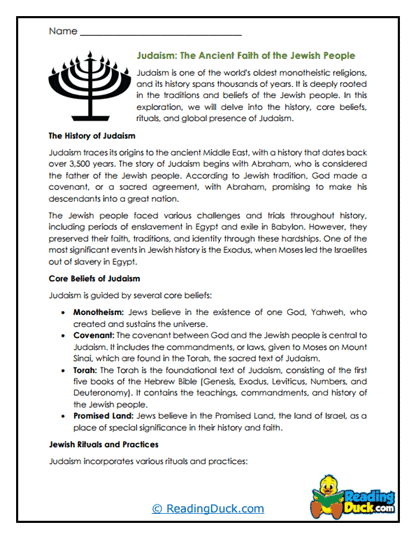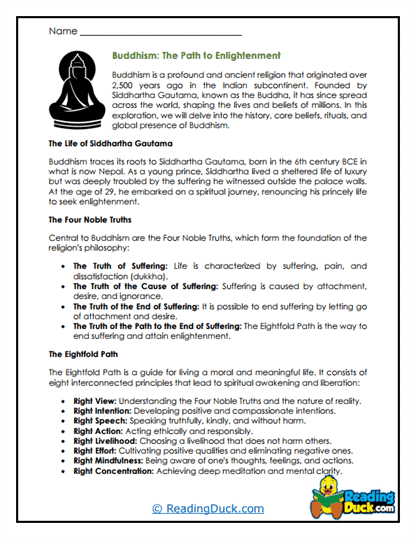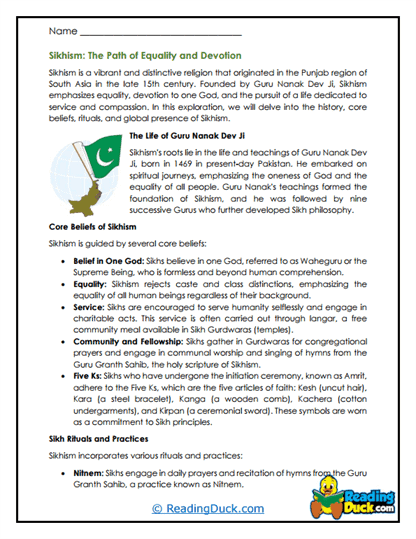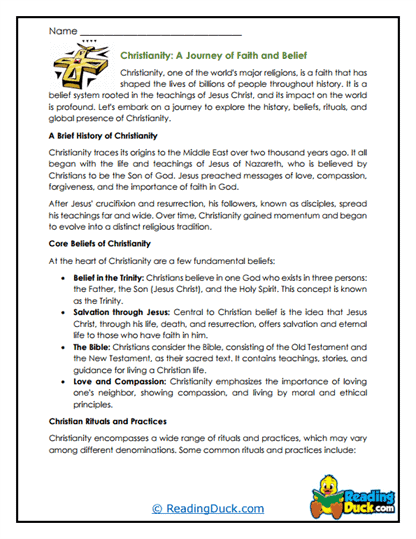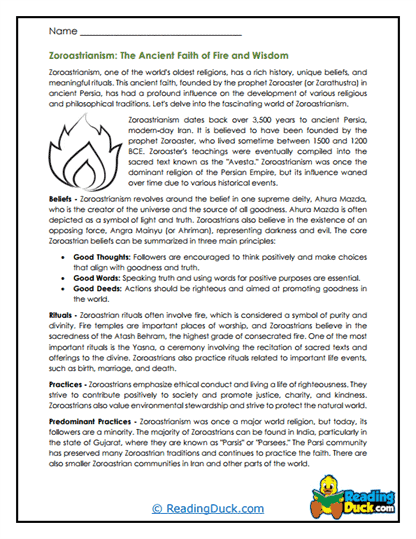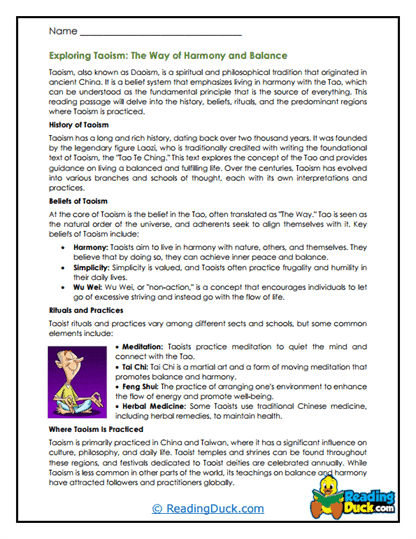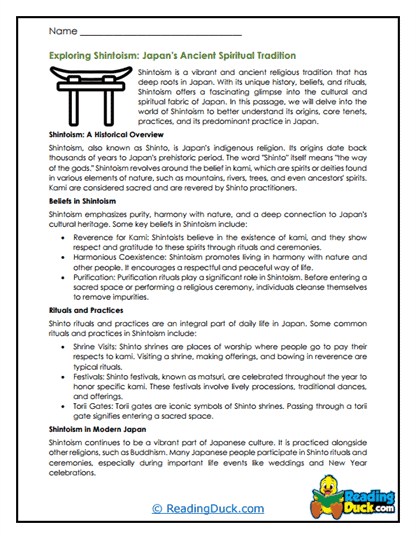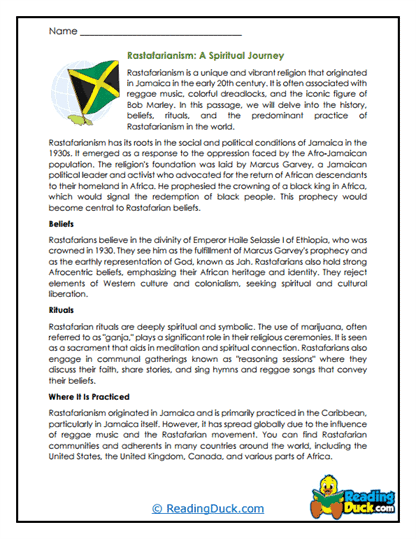World Religions Worksheets
About Our World Religions Worksheets
Our World Religions Worksheets offer students an insightful and comprehensive exploration of the major religions that shape cultures and societies across the globe. These worksheets delve deeply into the beliefs, practices, histories, and cultural impacts of various world religions, providing students with a well-rounded understanding of how religion influences individual lives and societal structures. While the worksheets are part of the "Culture" category, they specifically focus on the topic of world religions themselves, exploring each in its own context rather than comparing them across different cultures.
This topic contains several worksheet sets, each focusing on a specific aspect of world religions. Each worksheet set includes:
- Multiple Choice Questions: These questions assess students' comprehension of the reading passages, focusing on key details about religious beliefs, practices, historical figures, and significant events in each religion.
- Short Answer Questions: Students provide concise responses, summarizing important information, analyzing the influence of religion on culture, and reflecting on the role of religion in the lives of individuals and communities.
- Open-Ended Questions: These questions encourage students to think critically and express their personal interpretations, opinions, and preferences related to the religious topics they have read about, deepening their connection to the material.
These worksheets help students demonstrate their understanding of world religions while fostering meaningful engagement with the subject. An answer key is provided for each question sheet, making it easy for teachers and parents to evaluate student progress. All worksheets are available as PDF files, which can be easily viewed electronically, downloaded, and printed.
Understanding World Religions: Exploring Beliefs, Practices, and Cultural Impact
Religion is a fundamental aspect of human culture, influencing everything from daily practices to social values and historical events. The study of world religions provides students with a window into the diverse ways in which people understand the divine, seek meaning in life, and connect with their communities. By exploring world religions, students gain a deeper appreciation for the beliefs and practices that shape the lives of billions of people around the world. This exploration not only enhances their knowledge but also fosters empathy and respect for cultural and religious diversity.
When studying world religions, students encounter a variety of key concepts and areas of interest:
- Overview of Major World Religions: The worksheets provide students with a foundational understanding of the major world religions, including Christianity, Islam, Hinduism, Buddhism, Judaism, and others. Students learn about the core beliefs, sacred texts, religious leaders, and significant rituals associated with each religion. This overview helps students grasp the fundamental tenets of each religion and how they compare in terms of beliefs, practices, and influence on culture.
- Historical Development of Religions: Every religion has a rich history that reflects the evolution of human thought, culture, and society. Students explore the origins of each religion, tracing its development from its founding to its current form. They examine the key events, figures, and movements that have shaped each religion, such as the life of the Buddha, the spread of Islam, or the Reformation in Christianity. This historical perspective helps students understand how religions have evolved over time and how they have interacted with other cultures and belief systems.
- Religious Practices and Rituals: Religious practices and rituals are central to the expression of faith and are deeply embedded in the cultural life of communities. Students learn about the various rituals, ceremonies, and practices that are integral to each religion, such as prayer, meditation, fasting, and pilgrimage. They explore how these practices vary within different branches or sects of the same religion and how they are observed in different cultural contexts. This study of religious practices helps students appreciate the diversity of religious expression and the importance of ritual in fostering community and individual spirituality.
- Sacred Texts and Teachings: Sacred texts are the foundation of religious belief systems, providing guidance, teachings, and stories that shape the faith of believers. Students delve into the key texts of each religion, such as the Bible in Christianity, the Quran in Islam, the Vedas in Hinduism, and the Tripitaka in Buddhism. They explore the teachings contained within these texts, the ways in which they are interpreted by different communities, and their role in religious practice and education. This focus on sacred texts enhances students’ understanding of the doctrinal and ethical principles that guide religious life.
- Religious Festivals and Holidays: Festivals and holidays are important expressions of religious faith and community identity. Students study the major religious festivals associated with each religion, such as Christmas and Easter in Christianity, Ramadan and Eid in Islam, Diwali in Hinduism, and Hanukkah in Judaism. They learn about the customs, symbols, and traditions associated with these celebrations, as well as their significance in the religious calendar. This exploration of religious festivals helps students understand the role of these events in reinforcing religious beliefs and fostering a sense of belonging.
- The Role of Religion in Society: Religion plays a significant role in shaping social values, laws, and cultural practices. Students examine how religions influence societal norms and ethical standards, from concepts of justice and charity to views on marriage and family. They also explore the role of religion in social movements, such as the civil rights movement in the United States or the role of Hinduism in India’s independence struggle. This study of the societal role of religion encourages students to think critically about the ways in which religion interacts with and influences social structures and political systems.
- Religious Diversity and Interfaith Dialogue: In today’s globalized world, understanding religious diversity and promoting interfaith dialogue are more important than ever. Students explore the challenges and opportunities that arise in multi-religious societies, learning about the importance of tolerance, respect, and dialogue between different faith communities. They examine case studies of interfaith initiatives and consider the role of religion in promoting peace and understanding in a diverse world. This focus on religious diversity helps students develop the skills and attitudes needed to navigate and contribute positively to a multicultural society.
Through these topics, students gain a comprehensive understanding of world religions as both belief systems and cultural phenomena. They learn to appreciate the complexity of religious life and the ways in which religion shapes and reflects human experience.
Where To Use These Worksheets
Integrating world religions worksheets into a curriculum can enhance students' learning experience across various subjects and grade levels. Here are some practical ideas on how and where these worksheets can be used:
- Social Studies and History Classes: Use these worksheets to explore the historical development and cultural impact of world religions. Students can study how religions have influenced the course of history, from the spread of empires to the development of art and architecture. They can also explore the role of religion in shaping cultural practices, social norms, and legal systems. This approach helps students connect the study of history with the religious beliefs and practices that have influenced societies around the world.
- Literature and Language Arts Classes: Incorporate the worksheets into literature and language arts lessons to explore the role of religion in storytelling and literary traditions. Students can analyze religious themes and symbolism in literature, such as the portrayal of religious figures, the use of religious allegory, or the influence of sacred texts on literary works. They might also write their own stories or essays that reflect on religious themes or explore the role of religion in their own lives. This approach encourages students to think critically about the ways in which religion influences language, narrative, and meaning.
- Philosophy and Ethics Classes: Use the worksheets to discuss the philosophical and ethical teachings of world religions. Students can explore the moral principles and ethical dilemmas presented in religious texts, such as concepts of justice, compassion, and the nature of good and evil. They can also engage in debates or discussions on contemporary ethical issues, considering how different religious traditions approach questions of morality and justice. This approach helps students develop their critical thinking skills and deepen their understanding of ethical reasoning.
- Art and Cultural Studies Classes: Include the worksheets in art and cultural studies lessons to explore the influence of religion on art, architecture, and cultural practices. Students can study religious art and iconography, from Christian cathedrals to Buddhist statues, and consider how religious beliefs are expressed through artistic forms. They might also explore the role of religion in cultural traditions, such as religious music, dance, and festivals. This approach encourages students to appreciate the diversity of religious expression and its impact on cultural life.
- Civics and Global Studies Classes: Use the worksheets to explore the role of religion in global affairs and civic life. Students can examine how religious beliefs and institutions influence politics, international relations, and social movements. They can also explore the challenges of religious pluralism in diverse societies and the importance of interfaith dialogue in promoting peace and understanding. This approach helps students develop a global perspective on religion and its role in shaping the world.
- Extracurricular Activities: Use the worksheets in religious studies clubs or as part of extracurricular activities focused on culture and diversity. Students can apply the knowledge they gain from the worksheets to organize interfaith dialogues, visit local places of worship, or create presentations on different world religions. These activities enhance students’ understanding of religion and its role in fostering community and intercultural understanding.
Skill Development Through World Religions Worksheets
Studying world religions through these worksheets can significantly enhance students' critical thinking, cultural awareness, and ethical reasoning skills. Religion is a complex and multifaceted subject that requires students to consider diverse perspectives, question assumptions, and engage in reflective thinking. By exploring world religions, students develop a deeper appreciation for the diversity of human belief and the ways in which religion shapes culture, identity, and social life.
In addition to academic benefits, studying world religions helps students build empathy, respect, and open-mindedness. Understanding the role of religion in different cultures fosters a sense of global citizenship and encourages students to engage positively with people of different faiths. It also equips them with the skills needed to navigate the challenges of living in a diverse and interconnected world.
Overall, these world religions worksheets provide a comprehensive and engaging way for students to explore the rich diversity of religious traditions, gain a deeper understanding of their cultural significance, and develop skills that will serve them in their academic and personal lives.
